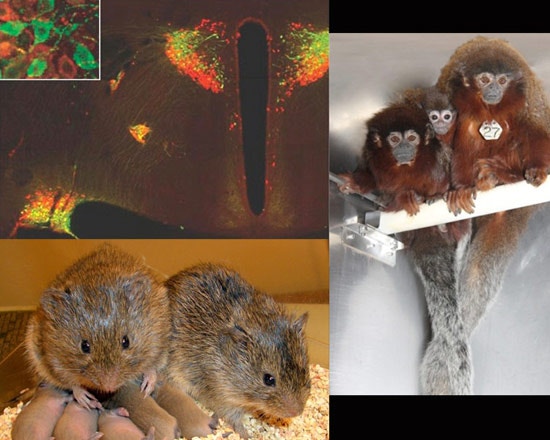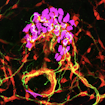
A number of studies have suggested that the so-called ‘love hormone’ oxytocin enhances trust, emotion recognition and even empathy in the typical population. Preliminary studies suggest that it could also improve some of the social deficits characteristic of people with autism.
On 11 April, SFARI hosted a workshop to explore oxytocin’s relationship to social behavior and its potential as a therapy for autism. The participants concluded that researchers should aim to better understand the oxytocin system in people.
There is also a need for rigorous clinical trials to study oxytocin’s effects on the social deficits in autism and to explore to explore alternative methods of treating people with the hormone.
Researchers identified oxytocin more than 100 years ago when they discovered that it regulates uterine contraction and milk ejection. More recently, animal models have linked the peptide to a wide array of reproductive and social functions, including enhancing bonding between mates, maternal behavior and alleviating anxiety and stress.
Harold Gainer, senior investigator of neuroscience at the National Institutes of Health, summarized some of the published literature on oxytocin function at the workshop.
Oxytocin is conserved in both structure and function across diverse species, suggesting that many of the findings in animal models are likely to be applicable to humans.
The oxytocin receptor — which directs changes in the cell in response to oxytocin — shows considerable variation both within and among species, however. Interestingly, having more receptors in the reward area of the brain enhances the social functions of oxytocin, such as pair-bonding. This finding provided some of the first evidence that oxytocin may be a regulator of general social behavior.
Animal models:
To directly test the function of oxytocin on social behavior, Larry Young, professor of neuroscience at Emory University in Atlanta, Georgia, examined genetically engineered mice lacking the oxytocin protein. These animals show a number of social impairments. As infants, they make fewer vocalizations when separated from their mothers and their peers.
As adults, the mice have “social amnesia,” meaning that they tend to not remember familiar mice. Control mice typically habituate to the presence of other mice and spend more time sniffing new mice than familiar ones. Oxytocin-deficient mice don’t develop this familiarity despite showing normal discrimination of non-social stimuli such as fruit scents. These deficits are caused by impairments in social recognition and memory, said Young.
Sue Carter and colleagues have also linked oxytocin to affiliative behavior and pair-bonding in a non-traditional animal model: the prairie vole. Prairie voles are socially monogamous rodents that form long-lasting social bonds.
Injecting oxytocin into the brain of prairie voles induces formation of these bonds and injecting a molecule that blocks the oxytocin receptor prevents them, studies have shown.
Despite being physically and genetically similar to prairie voles, meadow voles, a closely related species, are asocial and do not form monogamous bonds. Meadow voles have fewer oxytocin receptors in the nucleus accumbens, a brain region that mediates reward, compared with prairie voles. An interaction between the oxytocin system and the reward system may make social interactions a positive experience, said Young.
Because social behavior is complex, non-human primates should provide unique insights into the role of oxytocin in mediating social behavior. Unlike rodents, non-human primates and humans have similar cortical complexity, genetic variation, neurochemical systems and structure of the hippocampus — a brain region involved in learning and memory.
Karen Bales, associate professor of psychology at the University of California, Davis, studies the titi monkey, or Callicebus cupreus, the only truly monogamous monkey species. Like prairie voles, these animals form long-lasting pair bonds and both parents care for their offspring. Researchers can manipulate these bonds to better understand the mechanisms underlying social learning in primates.
Bales and Young are mapping the distribution of the oxytocin receptor within the titi monkey brain, which could help researchers understand where oxytocin functions in the human brain.
Oxytocin and development:
Doctors in North America and elsewhere often use a synthetic form of oxytocin, called pitocin, to induce labor, even though little is known about the long-term consequences for either mother or baby, according to Sue Carter, co-director of the Brain-Body Center at the University of Illinois at Chicago.
However, the oxytocin system develops dynamically and early-life manipulations can have long-lasting effects on social behavior, Carter said.
Newborn voles exposed to oxytocin show a U-shaped response to the levels of the hormone: Animals exposed to either low or high doses of the hormone are less likely to form pair bonds in adulthood than those that receive intermediate doses. In fact, newborn animals that receive the highest doses of oxytocin prefer strangers to familiar animals.
A single injection of oxytocin into adult prairie voles stimulates a higher-than-normal release of the body’s natural oxytocin. Long-term administration of oxytocin also increases the number of oxytocin-producing cells in the brain, Carter said.
Early-life experiences can also have a profound effect on the organization of the oxytocin system, Carter added. Putting a mother prairie vole under stress makes her offspring less anxious and more social later in their lives.
This change may be caused by epigenetics — changes in gene expression that are unrelated to DNA sequence. Treatment with oxytocin is associated with an increase in methylation, a chemical modification of the oxytocin receptor gene (OXTR) that influences gene expression, Carter and her colleagues found.
These treatments silence the OXTR gene and reduce the amount of oxytocin receptor in the brain. Paradoxically, these animals are more social than average, possibly because they increase the production of endogenous oxytocin to compensate for the decrease in receptors.
A number of experiments suggest that peripherally administered oxytocin can influence behavior. Early studies in rats suggested that oxytocin does not easily cross the blood-brain barrier, encouraging researchers to use a nasal spray that can easily enter the nervous system.
Studies with intranasal oxytocin suggest that the hormone can enhance empathy in the general population, including increasing trust, lowering activation of the amygdala — a brain region involved in emotion and fear — and improving performance on the ‘Reading the Mind in the Eyes’ task, in which people identify an emotion based only on a picture of the eyes. In each of these tests, oxytocin improves empathy and socially based learning, suggesting that it could treat some of the social deficits in autism.
Studies have shown that people with autism who sniff oxytocin improve on the ‘Reading the Mind in the Eyes’ task and are more likely to identify cooperative players in a computer ball-playing game than those who take placebo.
Identifying emotions in real life is much more complex than judging emotions based on pictures, however, noted Jennifer Bartz, assistant professor of psychiatry at the Mount Sinai Medical Center in New York City.
Bartz studies the effects of intranasal oxytocin on empathy using videos of people discussing real-life emotionally charged events — positive experiences such as getting engaged or negative experiences such as losing a job.
Participants in the study are members of the general population but took the Autism Screening Questionnaire — a self-reporting test that measures the degree of autism-associated behaviors.
Intranasal oxytocin improves accuracy only in those who are less empathetic than average and who have more autism-like behaviors, the study found.
Her team also plans to look at the effect of intranasal oxytocin on empathic accuracy in adults with autism and to use functional magnetic resonance imaging to try to pin down the brain regions involved.
Studies by Eric Hollander, professor of psychiatry at the Albert Einstein School of Medicine in New York City, also show that injecting oxytocin into the blood of people with autism helps them learn to identify the emotion in the tone of a person who says a neutral sentence, such as “The boy went to the store.”
Preliminary results suggest that administering intranasal oxytocin twice a day for six weeks also improves repetitive behaviors and social deficits in people with autism, Hollander said.
From test to trial:
These findings, coupled with the inefficacy of most available therapeutics at treating the core symptoms of autism, suggest that larger-scale clinical testing of intranasal oxytocin is needed.
There was some debate at the workshop about how a trial of that sort should be designed, however. Preliminary studies have used varying amounts of oxytocin, suggesting that the dose and the timing of treatment need to be pinned down. Two doses of intranasal oxytocin — 24 and 40 international units — administered twice daily, should be compared with the placebo treatment, Hollander suggested.
Researchers also need to determine how best to measure efficacy of the drug. Measurements should include a social task, such as the ‘Reading the Mind in the Eyes’ task and a quantifiable biomarker, such eye gaze patterns on face images, participants suggested. They should also include validated scales of autism phenotypes, such as the Yale-Brown obsessive compulsive scale and a test for social anxiety, such as the Liebowitz Social Anxiety Scale.
There is also limited research on the difference between injected and intranasal oxytocin. Despite the generally accepted belief that oxytocin has better access to the brain when sniffed, there is little published data to support this hypothesis. There is also evidence from animal studies to suggest that intranasal oxytocin may not be directly absorbed into the brain, even though brain levels of oxytocin increase.
One alternative to treating people with oxytocin is to induce natural oxytocin release in the brain, Young said. Certain drugs can easily cross the blood-brain barrier and use natural mechanisms to induce the brain to release oxytocin.
Young presented evidence that drugs that indirectly stimulate oxytocin release enhance pair-bonding in voles. These drugs warrant investigation in primate models and in people. However, Young cautioned that if the drugs are found to be effective at improving social cognition in people, they should only be used in conjunction with behavioral therapies by trained health professionals.
In conclusion, studies have implicated oxytocin in a number of different social behaviors in both animal models and people. Preliminary evidence suggests that oxytocin may also rescue some of the social and repetitive impairments in autism. More work is required, however, to better understand the best way to enhance the oxytocin system and to clinically test these treatments.


